Gang violence and hostage-taking sow fear across Ecuadorian social media
Graphic content related to violent incidents in Ecuador has garnered millions of views on X, the platform formerly known as Twitter
Gang violence and hostage-taking sow fear across Ecuadorian social media
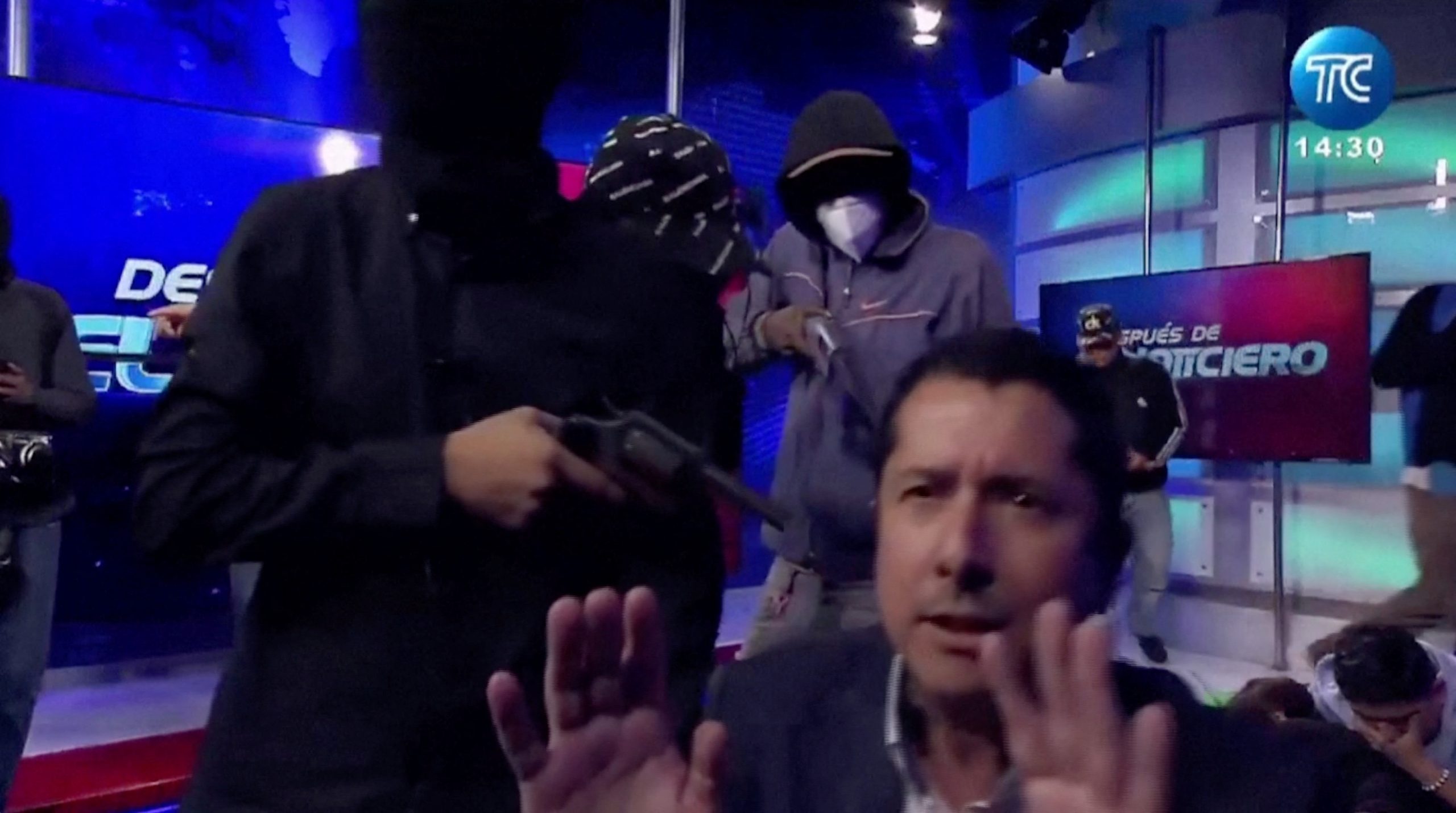
BANNER: A hooded man points a gun at Ecuadorian TV presenter Jose Luis Calderon while on air inside Ecuador’s TC television station, in Guayaquil, Ecuador, on January 9, 2024. (Source: TC/Handout via Reuters)
A DFRLab analysis of the spread of footage depicting incidents of recent violence in Ecuador reveals that an armed attack on TC Televisión significantly heightened the public’s attention to distressing and violent videos emerging from Ecuador’s prisons, leading to their widespread circulation on social media. Our analysis also revealed distinct narrative clusters in social media discussions, particularly revolving around the TV station assault, student panic at the University of Guayaquil, and general reactions to violent prison incidents.
On January 8, 2024, Ecuadorian President Daniel Noboa declared a sixty-day state of emergency following the escape of a notorious gang leader from a low-security prison. This declaration empowers the mobilization of the armed forces to strengthen domestic national security, working in conjunction with the national police; it also includes specific objectives to regain control of the country’s prison system.
The situation in Ecuador has significantly deteriorated in the wake of the declaration, especially in its prisons. At the time of writing, the official account of the National Comprehensive Care Service for Adults Deprived of Liberty reported that over 150 prison staff, including guards, were being held hostage by inmates in Ecuadorian prisons. Disturbing videos started circulating on social media showing extreme violence directed at the prison staff, including shootings and hangings. In these videos, the footage showed prison guards lying on the floor, coerced into reading a prepared message pleading with President Noboa to refrain from deploying military forces to the prisons.
Ecuador has faced a series of domestic challenges in recent years, including protests, political instability, and a surge in violence and organized crime. Violence and insecurity have been on the rise, with a reported six-fold increase in the country’s homicide rate since 2019. The country has also been grappling with unprecedented electoral shifts, which was underscored by the dissolution of its parliament in May 2023 and subsequent snap elections set against a backdrop of social, political, and security crises. The elections came about as a consequence of a presidential impeachment attempt; it was further complicated following the assassination of presidential candidate Fernando Villavicencio in August 2023.
In December 2023, Ecuadorian Attorney General Diana Salazar further exposed this surge in violence in an investigation that became known as the Metastasis Case. It revealed deep-rooted corruption within the country, including Ecuador’s political, judicial, and security landscapes. The investigation resulted in the arrest of approximately thirty individuals, making it one of Ecuador’s largest operations in its fight against corruption and drug trafficking.
Discussion spikes following television channel attack
On January 9, 2024, in retaliation to Noboa’s state of emergency the previous day, a group of armed men broke into state-owned television channel TC Televisión in Guayaquil during a live broadcast and subsequently threatened the journalists on air. Captured on video, the incident circulated widely on social media platforms.Using the social media analysis tool Meltwater Explore, the DFRLab identified more than 200,000 tweets posted to X (formerly known as Twitter) between 2:20 P.M. to 11:59 P.M. local time that day discussing the assault on the television studio.
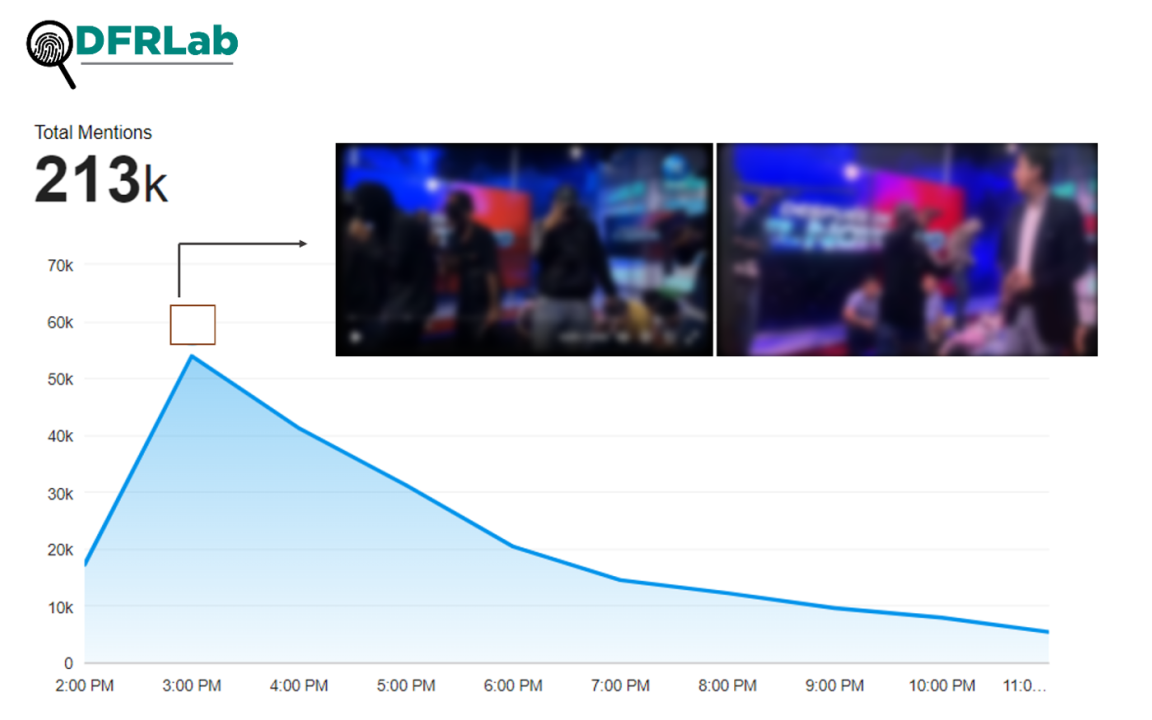
In the midst of the incident at TC Televisión, videos emerged online showing students from the University of Guayaquil in a state of panic, reportedly out of fear of potential abduction by armed individuals. The university later clarified that the videos showed students urgently leaving the campus to get safely home rather than any incidents of violence occurring at the university itself.
In direct response to the assault on TC Televisión, Noboa issued an executive decree declaring an “Internal Armed Conflict” in Ecuador, designating twenty-two criminal gangs as “terrorists.” Noboa also issued a direct order to the armed forces to carry out military operations aimed at neutralizing the groups involved in the escalating violence. This decree is seen as a crucial turning point in the Ecuadorian government’s strategy, potentially leading to increased military presence and action within the country.
Graphic footage goes viral, spreads to niche platforms
The shocking assault on TC Televisión on January 9 served as a pivotal moment in the dissemination of disturbing videos from within Ecuador’s prisons. While many of these videos, which depict the brutal treatment of security guards, initially emerged the previous day, their circulation on social media gained considerable momentum following the attack on the television studio. This appears to have acted as a catalyst for broader dissemination, intensifying domestic and global public attention and leading to a significant amplification of these videos.
Graphic video posts on X depicting the hostage situation within Ecuador’s prisons rapidly accumulated millions of views. Despite the removal of some of these posts and videos containing such graphic videos, widespread sharing and re-uploading nonetheless exposed large numbers of platform users to this graphic content.
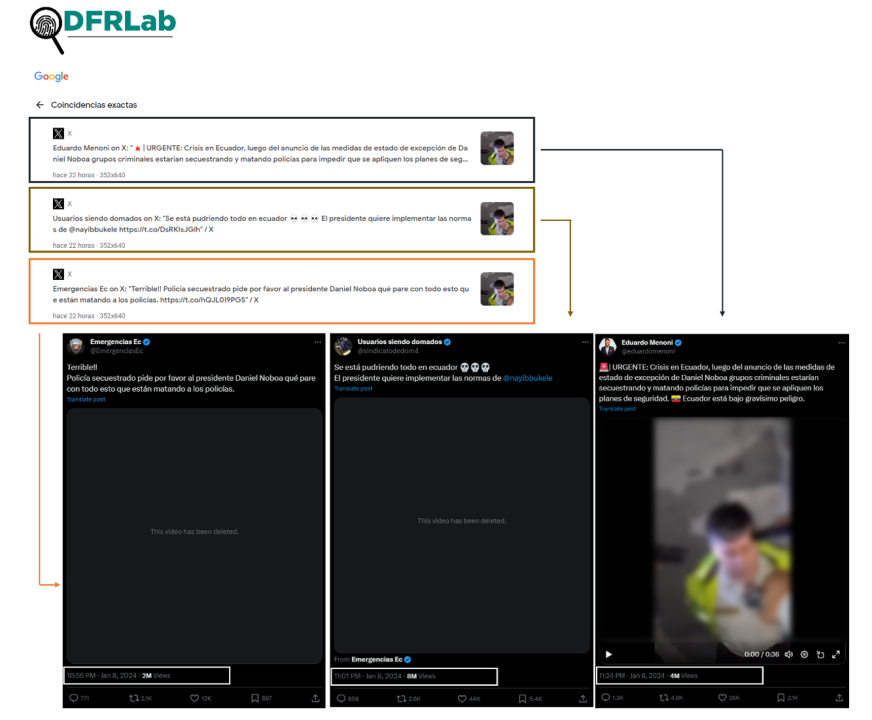
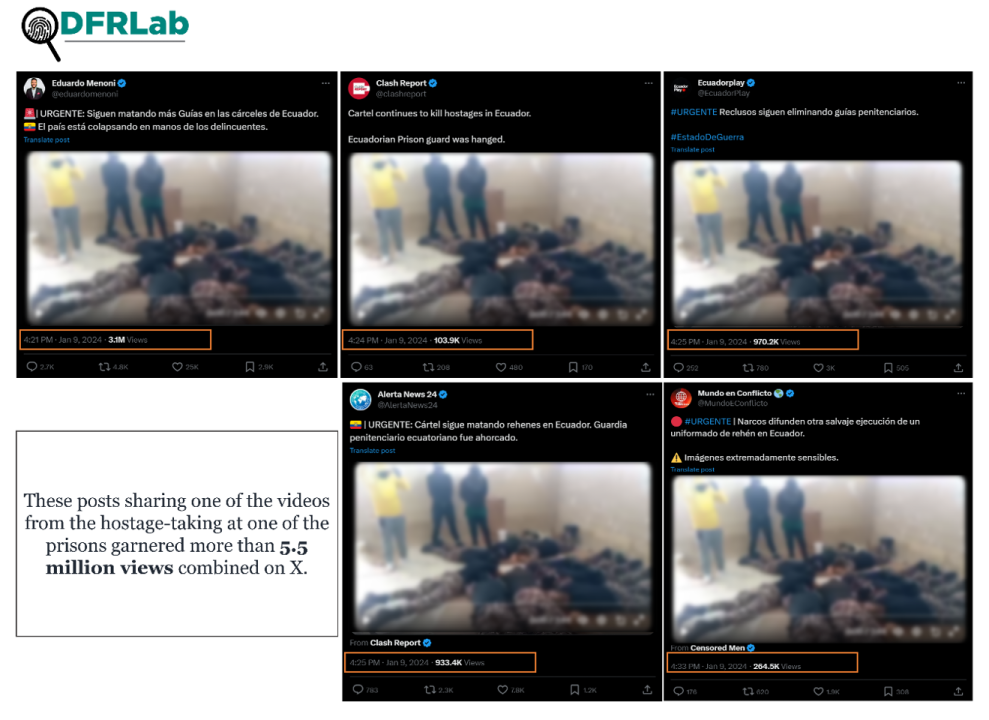
Additionally, the graphic nature of the videos showing security guards subjected to violence has led to their dissemination on websites specifically dedicated to showcasing footage of executions. This type of dissemination goes beyond mere sharing, potentially glorifying and normalizing extreme violence. The footage’s pathway from mainstream social media to niche websites raises serious concerns about the potential psychological impact on individual online users.
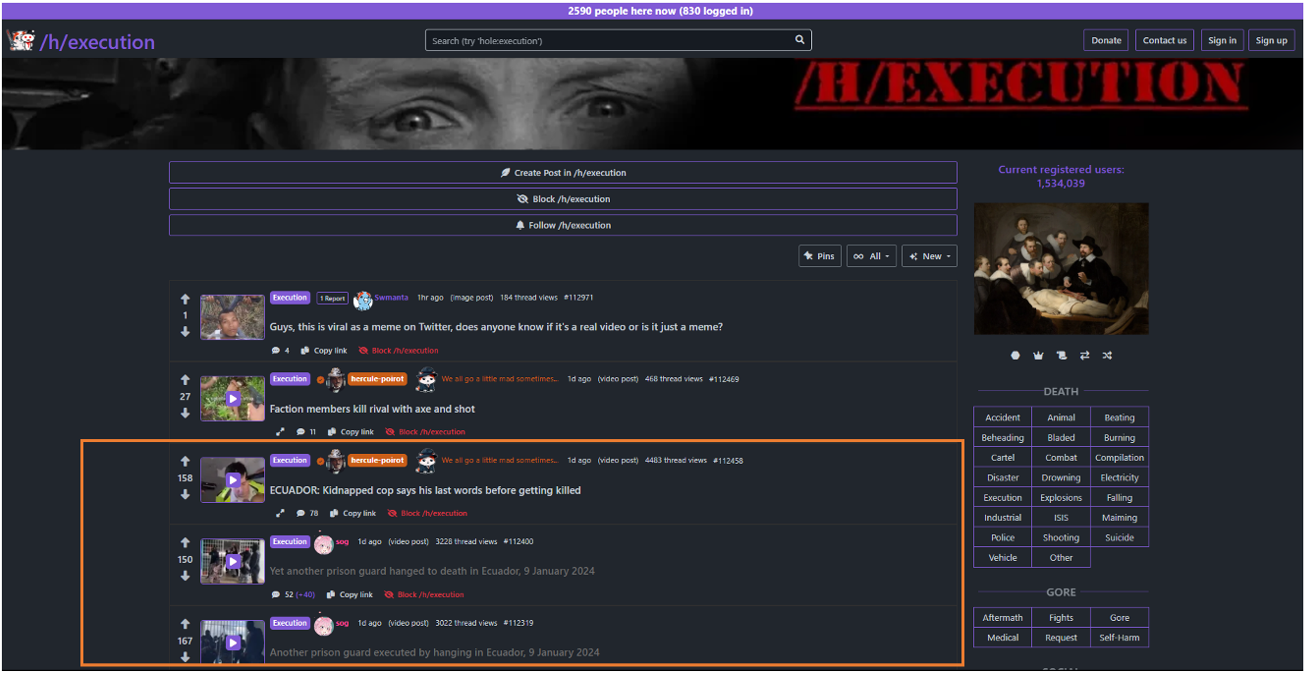
Narratives clusters
The DFRLab also conducted an analysis of approximately 15,000 user replies to X posts that shared footage of both hostage-taking incidents and students in panic from the University of Guayaquil. This research specifically targeted the most engaged-with posts, which collectively garnered millions of views.
The analysis aimed to understand the narratives toward these unfolding events. To perform this analysis, the DFRLab created text embeddings for each X reply, a process that translates the complex language of tweets into numerical data that can then be compared using machine learning and other techniques to identify similarities. Using TensorFlow Projector, the DFRLab then visualized the embeddings to identify patterns and clusters. Following this process, we identified three major narrative clusters discussing the assault on the TV station, the panic from students at the University of Guayaquil, and reactions to the incidents in the prisons. There were also smaller sub-clusters of new narrative spinning off from the other three discussion clusters; notably, one sub-cluster growing out of the prison violence discussions focused on El Salvador President Nayib Bukele and his own actions against gangs in his country.
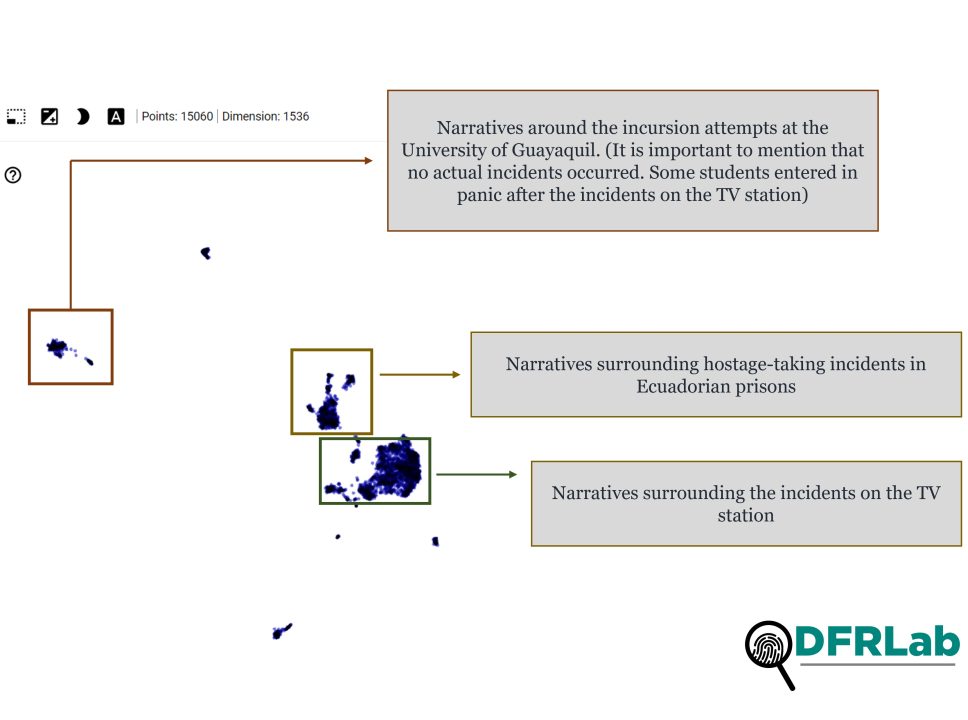
At the time of publishing, the situation in Ecuador continues to unfold, as authorities work to restore order and ensure the safety of the hostages and the general public. The gangs are using violence and unrest to sow fear and create a narrative of terror, and our analysis of initial social media traffic indicates that those narratives are indeed taking root.
Cite this case study:
Esteban Ponce de León, “Gang violence and hostage-taking sow fear across Ecuadorian social media,” Digital Forensic Research Lab (DFRLab), January 22, 2024, https://dfrlab.org/2024/01/22/gang-violence-and-hostage-taking-sow-fear-across-ecuadorian-social-media.

